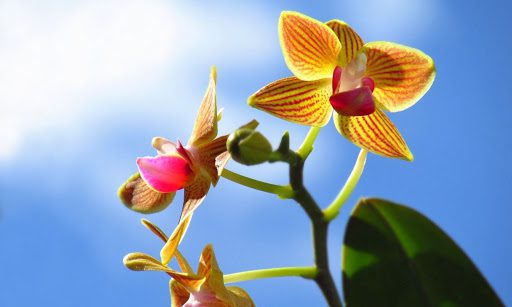Discover the answers to your most frequently asked questions about orchid lighting including how much light do orchids need?
Like all plants, orchids only need a few essentials in order to grow big and healthy and live for many years. Along with the right potting mix, fertilizer, and water, your orchid needs proper light conditions to thrive and boast big, beautiful blooms.
But sometimes finding the best lighting conditions for your orchid can seem tricky. Too much sun and your plant will become distressed. Too little and your orchid won’t bloom at all.
So today, we’re taking the guesswork out of orchid lighting by answering the 7 most commonly asked questions on orchid light requirements so you can find the perfect spot for your plant and watch it thrive year-round.
Question 1: How much light do orchids need?
The specific amount of light your orchid needs depends on its species. In the wild, some orchids grow in dappled light conditions while others thrive in environments that offer plenty of shade. That being said, more often than not, tropical orchids require bright, indirect sunlight to encourage bloom and maintain a hearty root system.
Professional Tip: Keep in mind that while indirect sunlight is crucial to maintain a healthy orchid, periods of nighttime darkness are essential for the blooming process too. The key is to offer your plant a balance of daytime light and nighttime darkness.
Question 2: How can I tell if my orchid is getting too much light?
One of the main signs your orchid is receiving too much light is discolored foliage. Red or purple leaves usually indicate that your plant is sunburnt. Your orchid needs healthy leaves to thrive, so damaged foliage is a sure sign that your plant is suffering.
Sunburnt leaves might occur during summer months when the midday sun is strong. Be sure to reevaluate how much sun your orchid is getting at the start of each new season.
Professional Tip: To avoid overexposure to direct light, move your orchid a few feet away from the window or use a sheer curtain to shield it from direct rays.

Question 3: How can I tell if my orchid is getting too little light?
All plants use light to perform photosynthesis, an energy-production process that supports healthy foliage, new blooms, and overall plant growth. When your orchid appears limp or leggy, it’s likely suffering from too little light.
Ideally, place your plant out of the path of direct rays, but make sure it’s in a sunny room. For many orchid plants, south- or east-facing windows are best.
Professional Tip: If your orchid is in a dim room with little natural light, such as an office or north-facing room, you may need to reposition it so it has enough sunlight to produce new growth.
Question 4: What if my orchid gets plenty of light but doesn’t bloom?
If your orchid gets plenty of indirect sunlight but won’t bloom properly, the light may not be intense enough to stimulate new flower growth. Other symptoms of low light intensity are flimsy or weak stems, scraggly leaves, or irregular foliage coloring.
If you suspect your orchid is suffering due to low light intensity, move your plant to an east-facing window. This will ensure the orchid can bask in the morning sun rays. In climates with lots of cloud cover, a south-facing window may be best for optimal light intensity.
Professional Tip: Some growers prefer to measure light intensity with a light meter. This can help take the guesswork out of positioning your plant in optimal light conditions.
Question 5: Is my orchid getting enough sunlight during the winter months?
While it’s true that light intensity is reduced during the winter months, if your orchid is positioned in a well-lit room, it should have plenty of sunlight to remain happy and healthy.
Like most plants, orchids go through a necessary period of dormancy in the winter. Naturally, plants that are in a state of dormancy don’t use as much energy and, therefore, don’t need as much sunlight as during spring or summer months when they’re actively growing.
Professional Tip: When your orchid goes dormant, it requires less water. Be sure to pull back on your watering routine during the winter months so as not to encourage root rot.

Question 6: Can I use artificial light to grow my orchid?
Yes! Many growers choose to grow orchids indoors under fluorescent bulbs or full-spectrum LED grow lights. Artificial lighting is a popular choice among orchid enthusiasts because it’s easy to implement and control.
Perhaps the most convenient feature of artificial lighting is that a light garden can be set up almost anywhere. They can come in handy if you want to grow orchids in a basement or windowless room.
Professional Tip: When using artificial lighting, be sure to position the bulb a few feet above your orchid. If the bulbs are too close to your plant’s blooms or foliage, they may damage the orchid.
Question 7: Should I keep my orchid outdoors so it gets more light?
Typically, tropical orchids enjoy spending summer months outdoors. But keep in mind that many orchid species grow in dappled light conditions, so your orchid likely can’t withstand the all-day-long direct sunlight required to grow other garden plants like tomatoes.
To make sure your plant is doing well outdoors, monitor the color of its foliage. A healthy plant will have strong, light- or medium-green leaves. Orchids with deep-green leaves are likely in need of more light. Orchids with bleached or reddish leaves are likely receiving too much light.
Professional Tip: If you make changes to your orchid’s light conditions, do so gradually. Orchids can easily burn if exposed to too much light, so the more cautious you are, the better.
Use Houseplant Resource Center’s Premium Orchid Food
After you find the perfect spot for your orchid and you’re sure it’s getting proper light, lock in your orchid-growing success by applying an orchid fertilizer that’ll encourage your plant to grow rich green leaves and big, bountiful blooms.
Houseplant Resource Center’s Premium Orchid Food lets you grow orchids with ease—no matter which species you have. It’s gentle, easy to apply, and it won’t burn your orchid’s roots.
Here are a few of the features that’ll take you from orchid beginner to expert grower in no time:
- It’s easy to apply: The pre-mixed spray acts as a root stimulator for plants to improve their ability to use nutrients. This is especially important for young plants.
- It’s specially formulated: Sea kelp extract and humic acids address the unique needs of your orchid. With regular use, you’ll see healthy and vibrant orchids that grow larger year after year.
- It’s natural and gentle: The standard orchid fertilizer ratio is diluted, so it’s safe to use at every watering without burning your orchid’s roots.
- It works with many orchid varieties: Premium Orchid Food is compatible with many indoor varieties, including phalaenopsis, epidendrum, Miltonia, cattleya, vanda, cymbidium, and oncidium.
For best results, use Premium Orchid Food with Houseplant Resource Center’s Root Supplement. Then sit back and watch your orchid’s blooms explode.



